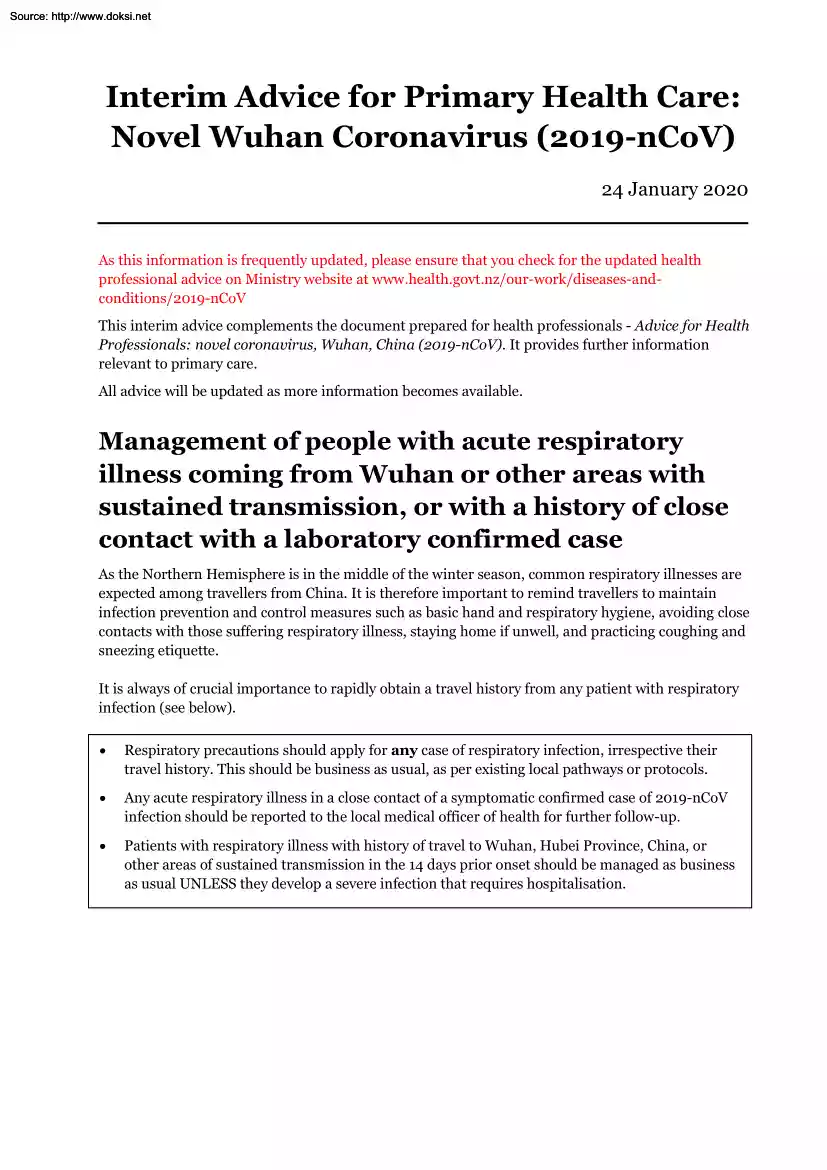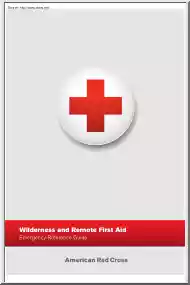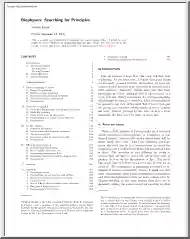A doksi online olvasásához kérlek jelentkezz be!

A doksi online olvasásához kérlek jelentkezz be!
Nincs még értékelés. Legyél Te az első!
Mit olvastak a többiek, ha ezzel végeztek?
Tartalmi kivonat
Source: http://www.doksinet Interim Advice for Primary Health Care: Novel Wuhan Coronavirus (2019-nCoV) 24 January 2020 As this information is frequently updated, please ensure that you check for the updated health professional advice on Ministry website at www.healthgovtnz/our-work/diseases-andconditions/2019-nCoV This interim advice complements the document prepared for health professionals - Advice for Health Professionals: novel coronavirus, Wuhan, China (2019-nCoV). It provides further information relevant to primary care. All advice will be updated as more information becomes available. Management of people with acute respiratory illness coming from Wuhan or other areas with sustained transmission, or with a history of close contact with a laboratory confirmed case As the Northern Hemisphere is in the middle of the winter season, common respiratory illnesses are expected among travellers from China. It is therefore important to remind travellers to maintain infection
prevention and control measures such as basic hand and respiratory hygiene, avoiding close contacts with those suffering respiratory illness, staying home if unwell, and practicing coughing and sneezing etiquette. It is always of crucial importance to rapidly obtain a travel history from any patient with respiratory infection (see below). • Respiratory precautions should apply for any case of respiratory infection, irrespective their travel history. This should be business as usual, as per existing local pathways or protocols • Any acute respiratory illness in a close contact of a symptomatic confirmed case of 2019-nCoV infection should be reported to the local medical officer of health for further follow-up. • Patients with respiratory illness with history of travel to Wuhan, Hubei Province, China, or other areas of sustained transmission in the 14 days prior onset should be managed as business as usual UNLESS they develop a severe infection that requires hospitalisation.
Source: http://www.doksinet Suspect Case Definition Patient with an acute severe respiratory infection that requires hospitalisation AND with history of travel to Wuhan, Hubei Province, China, and any other areas with sustained outbreaks in the 14 days prior to symptom onset, OR with a history of close contact with a symptomatic confirmed case in the 14 days prior to symptom onset • The patient will be investigated once hospitalised. • The local medical officer of health should be immediately informed • The local hospital should be contacted first before the patient is sent for assessment. • Usual respiratory precautions for viral respiratory infections (as per the local pathways or protocols) should apply before and during patient’s transfer to hospital. Patient with an acute respiratory illness not requiring hospitalisation AND with a history of close contact with a symptomatic confirmed case in the 14 days prior to symptom onset (irrespective of the travel history) •
The patient should be advised to self-isolate at home or in their accommodation. • The local medical officer of health should be immediately informed • Laboratory testing should be organised by the GP in consultation with the local medical officer of health, starting with the common respiratory infections (please refer to Annex 2) • Usual respiratory precautions for viral respiratory infections (as per the local pathways or protocols) should apply. The following should NOT be considered as a suspect case: Patient with an acute respiratory illness not requiring hospitalisation AND with history of travel to Wuhan, Hubei Province, China, or other areas with sustained outbreaks in the 14 days prior to symptom onset (no history of close contact with a confirmed case) • Business as usual, i.e usual respiratory precautions for viral respiratory infections (as per the local pathways or protocols) should apply. • The patient should contact their doctor or call Healthline if they
deteriorate. • No other actions are needed, unless the case becomes severe and requires hospitalisation. Minimum precautions to reduce the general risk of transmission of acute respiratory infections • Avoiding close contact with people suffering from acute respiratory infections. • Frequent hand-washing, especially after direct contact with ill people or their environment. • People with symptoms of acute respiratory infection should practice cough etiquette (maintain distance, cover coughs and sneezes with disposable tissues or clothing, and wash hands) and stay home if unwell. Source: http://www.doksinet • Adhere to standard infection prevention and control practices in primary care. All patients with respiratory infection and recent travel history should be provided with a surgical mask upon entry to the facility. For potential cases of novel coronavirus infection, include contact and droplet precautions, such as personal protective equipment (PPE). •
Aerosol-generating procedures should be avoided in Primary Health Care. If required, the patient should be referred to a laboratory or a hospital. Notify the laboratory or hospital prior to arrival. 3 Source: http://www.doksinet Annex 1 - Background information 1.1 Summary of the current situation A novel coronavirus currently called 2019-nCoV has caused a cluster of viral respiratory illness in Wuhan. The cluster was initially reported on 31 December 2019 The Chinese authorities identified a new type of coronavirus, which was isolated on 7 January 2020. Laboratory testing was conducted on all suspected cases identified through active case finding and retrospective review. Other respiratory pathogens such as influenza, avian influenza, adenovirus, Severe Acute Respiratory Syndrome coronavirus (SARS-CoV), and Middle East Respiratory Syndrome coronavirus (MERS-CoV) were ruled out as the cause. Detected case numbers have been increasing in Wuhan, and individual cases have been
detected in other countries and elsewhere in China. All cases to date have spent time in Wuhan The clinical signs and symptoms reported are mainly fever, with a few cases having difficulty in breathing, and chest radiographs showing invasive pneumonic infiltrates in both lungs. National authorities report that patients have been isolated and are receiving treatment in Wuhan medical institutions. According to the preliminary epidemiological investigation, many of the initial cases worked at or were handlers and frequent visitors to the Huanan Seafood Wholesale Market. The Huanan Seafood Wholesale Market has been temporarily closed to carry out environmental sanitation and disinfection. No cases of 2019-nCoV have been detected in New Zealand to date. 1.2 Where to get further information and advice Please see the webpages below for the latest information: • General information for the public: https://www.healthgovtnz/our-work/diseases-and-conditions/novel-coronavirus-china-2019-ncov
• World Health Organization (WHO) situation updates and advice: https://www.whoint/health-topics/coronavirus https://www.whoint/csr/don/en/ (updates only) 1.3 What is this novel coronavirus? Coronaviruses are a large and diverse family of viruses which include viruses that are known to cause illness in animals and in humans, including the common cold, Severe Acute Respiratory Syndrome (SARS) and the Middle East Respiratory Syndrome (MERS). The novel coronavirus detected in Wuhan (2019-nCoV) had not previously been detected in humans or animals. Phylogenetic analysis shows the coronavirus to be (distantly) related to SARS CoV, the virus responsible for the SARS pandemic which began in China in 20035. 5 https://www.ecohealthallianceorg/2020/01/phylogenetic-analysis-shows-novel-wuhan-coronavirus-clusters-withsars Source: http://www.doksinet 1.3 Interim risk assessment Recognising that this is a rapidly evolving situation, and based on the information currently available, the
Ministry’s risk assessment is that the risk of a sustained outbreak of 2019-nCoV infection in New Zealand is low. This assessment however recognises that there is a risk of 2019-nCoV infection being imported into New Zealand, especially given that the reported numbers are rapidly increasing overseas, New Zealand has close transport links to China, and the coming Chinese New Year celebrations. Because of the risk of future importation of cases to New Zealand from Wuhan (or possibly in another area with on-going outbreak), awareness of 2019-nCoV among health care professionals is essential, particularly those working in hospitals. It is always of crucial importance to rapidly obtain a travel history and implement precautionary infection prevention and control measures within hospitals to prevent transmission in healthcare settings. Given the evidence that human-to-human transmission of SARS and MERS viruses is increased in hospital settings, a cautious approach with patients with
symptoms of pneumonia and a history of travel to Wuhan is advised in these settings (please refer to Error! Reference source not found.) Strict adherence to infection prevention and control (IPC) protocols and procedures at all times is crucial. 1.4 Local readiness and response plans District Health Boards (DHBs) should ensure they have local readiness and response plans in place. Information has been provided for border health operations. As advised by WHO there are no travel restrictions and no specific measures for travellers in place. 5 Source: http://www.doksinet Annex 2 - Laboratory testing for diagnosis of 2019nCoV infection If a case of 2019-nCoV infection is suspected, requests for laboratory testing in Primary Health Care should be done in consultation with the local medical officer of health. Who do I test for 2019-nCoV? Testing should be considered for those meeting the suspect case definition. How do I test for 2019-nCoV? WHO interim recommendations on laboratory
testing for 2019-nCoV can be found on the WHO website at https://www.whoint/health-topics/coronavirus/laboratory-diagnostics-for-novelcoronavirus • Routine tests for acute pneumonia should always be performed first, including bacterial culture, serology, urinary antigen testing and tests for respiratory viruses, including influenza. • Contact the clinical microbiologist for diagnostic testing. • o Appropriate clinical specimens should be collected and transported to the microbiology laboratory under appropriate conditions o An adequate volume of clinical material should be sampled. More than one specimen type may need to be collected. o Repeat testing may be required but will be at the direction of the clinical microbiologist. In addition to standard, airborne precautions should be followed when collecting specimens if there is a risk of aerosol generation. The collection of specimens should occur in an airborne infection isolation room if available. Source:
http://www.doksinet Annex 3 - Contact tracing and contact management Contact tracing and contact management should be coordinated by the local public health unit. Purpose of contact tracing Contact tracing is required at this stage for the prevention of potential onward transmission, awareness-raising and early detection of suspected cases. Who is a close contact? • Anyone with direct contact with the case or their body fluids or their laboratory specimens, or in the same room of a healthcare setting when an aerosol generating procedure is undertaken on the case and who were not wearing appropriate PPE. • Anyone living in the same household as a 2019-nCoV case. • Anyone staying within 2 metres of the case in any other setting not listed above, for a prolonged period of time (>15 minutes). • Where a case has travelled on an airplane or any other conveyance while ill, close contacts include passengers seated in the same row as the case and two rows in front and behind
the case, and crew or passengers that have had face-to-face prolonged interaction (e.g 15 minutes) with, or contact with respiratory secretions of, the ill person. Management Investigation Close contacts of those meeting the suspect, probable or confirmed case definitions should be followed up by the public health unit and asked to report symptoms such as fever, respiratory symptoms, headache or muscle pain to their local public health unit. They should be tested for 2019-nCoV infection if respiratory symptoms develop (regardless of the severity of illness). Restriction In general quarantine of close contacts is not required. However, close contacts should be advised to immediately self isolate if symptoms develop and contact their local Public Health Unit. On a case by case basis, public health staff may request voluntary restrictions for close contacts. Counselling Advise all contacts of the estimated incubation period (14 days) and typical symptoms of 2019-nCoV (respiratory
illness, fever and cough). Ask them to contact their local public health unit and seek early medical attention if symptoms develop. 7
prevention and control measures such as basic hand and respiratory hygiene, avoiding close contacts with those suffering respiratory illness, staying home if unwell, and practicing coughing and sneezing etiquette. It is always of crucial importance to rapidly obtain a travel history from any patient with respiratory infection (see below). • Respiratory precautions should apply for any case of respiratory infection, irrespective their travel history. This should be business as usual, as per existing local pathways or protocols • Any acute respiratory illness in a close contact of a symptomatic confirmed case of 2019-nCoV infection should be reported to the local medical officer of health for further follow-up. • Patients with respiratory illness with history of travel to Wuhan, Hubei Province, China, or other areas of sustained transmission in the 14 days prior onset should be managed as business as usual UNLESS they develop a severe infection that requires hospitalisation.
Source: http://www.doksinet Suspect Case Definition Patient with an acute severe respiratory infection that requires hospitalisation AND with history of travel to Wuhan, Hubei Province, China, and any other areas with sustained outbreaks in the 14 days prior to symptom onset, OR with a history of close contact with a symptomatic confirmed case in the 14 days prior to symptom onset • The patient will be investigated once hospitalised. • The local medical officer of health should be immediately informed • The local hospital should be contacted first before the patient is sent for assessment. • Usual respiratory precautions for viral respiratory infections (as per the local pathways or protocols) should apply before and during patient’s transfer to hospital. Patient with an acute respiratory illness not requiring hospitalisation AND with a history of close contact with a symptomatic confirmed case in the 14 days prior to symptom onset (irrespective of the travel history) •
The patient should be advised to self-isolate at home or in their accommodation. • The local medical officer of health should be immediately informed • Laboratory testing should be organised by the GP in consultation with the local medical officer of health, starting with the common respiratory infections (please refer to Annex 2) • Usual respiratory precautions for viral respiratory infections (as per the local pathways or protocols) should apply. The following should NOT be considered as a suspect case: Patient with an acute respiratory illness not requiring hospitalisation AND with history of travel to Wuhan, Hubei Province, China, or other areas with sustained outbreaks in the 14 days prior to symptom onset (no history of close contact with a confirmed case) • Business as usual, i.e usual respiratory precautions for viral respiratory infections (as per the local pathways or protocols) should apply. • The patient should contact their doctor or call Healthline if they
deteriorate. • No other actions are needed, unless the case becomes severe and requires hospitalisation. Minimum precautions to reduce the general risk of transmission of acute respiratory infections • Avoiding close contact with people suffering from acute respiratory infections. • Frequent hand-washing, especially after direct contact with ill people or their environment. • People with symptoms of acute respiratory infection should practice cough etiquette (maintain distance, cover coughs and sneezes with disposable tissues or clothing, and wash hands) and stay home if unwell. Source: http://www.doksinet • Adhere to standard infection prevention and control practices in primary care. All patients with respiratory infection and recent travel history should be provided with a surgical mask upon entry to the facility. For potential cases of novel coronavirus infection, include contact and droplet precautions, such as personal protective equipment (PPE). •
Aerosol-generating procedures should be avoided in Primary Health Care. If required, the patient should be referred to a laboratory or a hospital. Notify the laboratory or hospital prior to arrival. 3 Source: http://www.doksinet Annex 1 - Background information 1.1 Summary of the current situation A novel coronavirus currently called 2019-nCoV has caused a cluster of viral respiratory illness in Wuhan. The cluster was initially reported on 31 December 2019 The Chinese authorities identified a new type of coronavirus, which was isolated on 7 January 2020. Laboratory testing was conducted on all suspected cases identified through active case finding and retrospective review. Other respiratory pathogens such as influenza, avian influenza, adenovirus, Severe Acute Respiratory Syndrome coronavirus (SARS-CoV), and Middle East Respiratory Syndrome coronavirus (MERS-CoV) were ruled out as the cause. Detected case numbers have been increasing in Wuhan, and individual cases have been
detected in other countries and elsewhere in China. All cases to date have spent time in Wuhan The clinical signs and symptoms reported are mainly fever, with a few cases having difficulty in breathing, and chest radiographs showing invasive pneumonic infiltrates in both lungs. National authorities report that patients have been isolated and are receiving treatment in Wuhan medical institutions. According to the preliminary epidemiological investigation, many of the initial cases worked at or were handlers and frequent visitors to the Huanan Seafood Wholesale Market. The Huanan Seafood Wholesale Market has been temporarily closed to carry out environmental sanitation and disinfection. No cases of 2019-nCoV have been detected in New Zealand to date. 1.2 Where to get further information and advice Please see the webpages below for the latest information: • General information for the public: https://www.healthgovtnz/our-work/diseases-and-conditions/novel-coronavirus-china-2019-ncov
• World Health Organization (WHO) situation updates and advice: https://www.whoint/health-topics/coronavirus https://www.whoint/csr/don/en/ (updates only) 1.3 What is this novel coronavirus? Coronaviruses are a large and diverse family of viruses which include viruses that are known to cause illness in animals and in humans, including the common cold, Severe Acute Respiratory Syndrome (SARS) and the Middle East Respiratory Syndrome (MERS). The novel coronavirus detected in Wuhan (2019-nCoV) had not previously been detected in humans or animals. Phylogenetic analysis shows the coronavirus to be (distantly) related to SARS CoV, the virus responsible for the SARS pandemic which began in China in 20035. 5 https://www.ecohealthallianceorg/2020/01/phylogenetic-analysis-shows-novel-wuhan-coronavirus-clusters-withsars Source: http://www.doksinet 1.3 Interim risk assessment Recognising that this is a rapidly evolving situation, and based on the information currently available, the
Ministry’s risk assessment is that the risk of a sustained outbreak of 2019-nCoV infection in New Zealand is low. This assessment however recognises that there is a risk of 2019-nCoV infection being imported into New Zealand, especially given that the reported numbers are rapidly increasing overseas, New Zealand has close transport links to China, and the coming Chinese New Year celebrations. Because of the risk of future importation of cases to New Zealand from Wuhan (or possibly in another area with on-going outbreak), awareness of 2019-nCoV among health care professionals is essential, particularly those working in hospitals. It is always of crucial importance to rapidly obtain a travel history and implement precautionary infection prevention and control measures within hospitals to prevent transmission in healthcare settings. Given the evidence that human-to-human transmission of SARS and MERS viruses is increased in hospital settings, a cautious approach with patients with
symptoms of pneumonia and a history of travel to Wuhan is advised in these settings (please refer to Error! Reference source not found.) Strict adherence to infection prevention and control (IPC) protocols and procedures at all times is crucial. 1.4 Local readiness and response plans District Health Boards (DHBs) should ensure they have local readiness and response plans in place. Information has been provided for border health operations. As advised by WHO there are no travel restrictions and no specific measures for travellers in place. 5 Source: http://www.doksinet Annex 2 - Laboratory testing for diagnosis of 2019nCoV infection If a case of 2019-nCoV infection is suspected, requests for laboratory testing in Primary Health Care should be done in consultation with the local medical officer of health. Who do I test for 2019-nCoV? Testing should be considered for those meeting the suspect case definition. How do I test for 2019-nCoV? WHO interim recommendations on laboratory
testing for 2019-nCoV can be found on the WHO website at https://www.whoint/health-topics/coronavirus/laboratory-diagnostics-for-novelcoronavirus • Routine tests for acute pneumonia should always be performed first, including bacterial culture, serology, urinary antigen testing and tests for respiratory viruses, including influenza. • Contact the clinical microbiologist for diagnostic testing. • o Appropriate clinical specimens should be collected and transported to the microbiology laboratory under appropriate conditions o An adequate volume of clinical material should be sampled. More than one specimen type may need to be collected. o Repeat testing may be required but will be at the direction of the clinical microbiologist. In addition to standard, airborne precautions should be followed when collecting specimens if there is a risk of aerosol generation. The collection of specimens should occur in an airborne infection isolation room if available. Source:
http://www.doksinet Annex 3 - Contact tracing and contact management Contact tracing and contact management should be coordinated by the local public health unit. Purpose of contact tracing Contact tracing is required at this stage for the prevention of potential onward transmission, awareness-raising and early detection of suspected cases. Who is a close contact? • Anyone with direct contact with the case or their body fluids or their laboratory specimens, or in the same room of a healthcare setting when an aerosol generating procedure is undertaken on the case and who were not wearing appropriate PPE. • Anyone living in the same household as a 2019-nCoV case. • Anyone staying within 2 metres of the case in any other setting not listed above, for a prolonged period of time (>15 minutes). • Where a case has travelled on an airplane or any other conveyance while ill, close contacts include passengers seated in the same row as the case and two rows in front and behind
the case, and crew or passengers that have had face-to-face prolonged interaction (e.g 15 minutes) with, or contact with respiratory secretions of, the ill person. Management Investigation Close contacts of those meeting the suspect, probable or confirmed case definitions should be followed up by the public health unit and asked to report symptoms such as fever, respiratory symptoms, headache or muscle pain to their local public health unit. They should be tested for 2019-nCoV infection if respiratory symptoms develop (regardless of the severity of illness). Restriction In general quarantine of close contacts is not required. However, close contacts should be advised to immediately self isolate if symptoms develop and contact their local Public Health Unit. On a case by case basis, public health staff may request voluntary restrictions for close contacts. Counselling Advise all contacts of the estimated incubation period (14 days) and typical symptoms of 2019-nCoV (respiratory
illness, fever and cough). Ask them to contact their local public health unit and seek early medical attention if symptoms develop. 7




